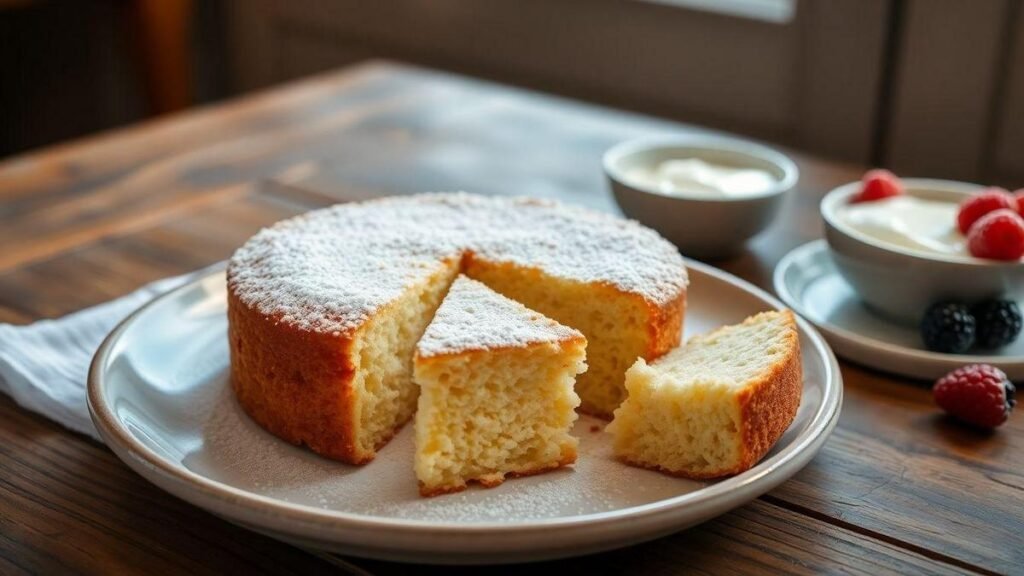I know how frustrating dry cakes feel. I baked the softest yogurt cake and I want to show you how yogurt makes a cake moist and tender. My recipe is simple and keeps the cake soft for days. I share the best types of yogurt, a soft vanilla base, tasty variations, optional toppings, and practical tips for baking and storage. Use it for breakfast, dessert, or a cozy snack — try it and you may add yogurt to every cake you make.
- Yogurt makes cakes very moist and tender
- Adds a mild tang without extra fat
- Plain or Greek yogurt works best for baking
- Base recipe is simple and easy to flavor
- Cake stays soft for days when stored properly
How to Make a Soft Cake Using Yogurt: Moist, Tender, and Full of Flavor
I love a cake that stays moist and tender for days. A scoop of yogurt does that magic. This is a simple path to a cake that feels like a warm hug. The steps are easy — learned from baking mistakes and small wins. Let’s get baking.
Why Use Yogurt in Cake?
Yogurt is the secret to a soft crumb. It adds moisture, a little tang, and helps produce a fine, light crumb. For more on creating reliably airy, soft cakes, see the guide to fluffy cakes and the secrets to soft, tasty results.
| Benefit | What it does |
|---|---|
| Moisture | Keeps cake soft even after days |
| Tender crumb | Makes texture fine and delicate |
| Flavor lift | Adds a mild tang that brightens taste |
| Less fat | You can cut back on butter or oil if you like |
I use yogurt when I want a reliable cake that doesn’t dry out. It’s simple and honest.
Best Types of Yogurt for Baking
I tested a few kinds. Here’s what works best:
| Yogurt type | Use when | Notes |
|---|---|---|
| Full‑fat plain | You want rich flavor | Best for very soft cake |
| Greek | You want thick batter | Thin with a little milk if batter is stiff |
| Low‑fat plain | You want fewer calories | Still moist but slightly less rich |
| Flavored | You want a quick flavor boost | Use carefully; may add extra sugar |
| Plant‑based (oat/soy) | Dairy‑free need | Use plain varieties for best texture — see options for making cakes without milk |
I usually reach for full‑fat plain — best balance of taste and soft crumb.
Soft Vanilla Yogurt Cake Recipe
I keep this recipe on hand. It’s simple and forgiving. Bake in a loaf pan or a 9-inch round. If you want a purely vanilla-focused approach using yogurt, this pairs nicely with the detailed moist vanilla cake method using yogurt.
Ingredients
| Ingredient | Amount |
|---|---|
| All‑purpose flour | 2 cups (240 g) |
| Sugar | 1 cup (200 g) |
| Baking powder | 2 tsp |
| Salt | 1/2 tsp |
| Eggs | 2 large |
| Plain yogurt | 1 cup (240 g) |
| Vegetable oil or melted butter | 1/2 cup (120 ml) — or swap for applesauce for a lighter cake |
| Vanilla extract | 1 tsp |
| Milk (if needed) | 1–2 tbsp |
No fancy tools required — a bowl and a spoon do the job. For more minimal equipment, check the one‑bowl cake recipes for busy days.
Instructions
- Preheat oven to 350°F (175°C). Grease a 9‑inch pan.
- Whisk dry ingredients: flour, sugar, baking powder, and salt.
- Whisk wet ingredients: eggs, yogurt, oil, and vanilla.
- Fold wet into dry. Stir just until combined — don’t overmix.
- If batter is thick, thin with 1–2 tbsp milk.
- Pour into pan and smooth the top.
- Bake 30–40 minutes. Test doneness with a toothpick.
- Cool 10 minutes in pan, then remove and cool on a rack.
A light mix keeps the crumb tender — treat the batter gently.
Result
| Texture | Flavor | Crust |
|---|---|---|
| Soft and tender | Mildly sweet, slight tang | Thin, golden |
Slice for breakfast or dessert — it stays soft for days.
Optional Toppings
Toppings make the cake feel festive with little effort:
- Powdered sugar — dust before serving
- Fresh berries — scatter on slices; learn how to use fruit as a natural cake topping
- Simple glaze (powdered sugar milk) — drizzle over warm cake; try a quick simple glaze for any cake
- Whipped cream — dollop on each slice
- Lemon zest — sprinkle for brightness
- Chopped nuts — add crunch
If you prefer no-fuss decorating, there are easy ideas for decorating without piping bags. I keep toppings ready in small bowls — guests feel spoiled.
Flavor Variations
Quick swaps to change the mood:
| Variation | Swap | Note |
|---|---|---|
| Lemon | Add 2 tbsp lemon juice zest | Bright flavor; reduce milk if batter thin |
| Orange | Use orange zest a bit of juice | Fresh and citrusy |
| Cinnamon | Add 1 tsp cinnamon | Warm and cozy |
| Chocolate | Replace 1/2 cup flour with cocoa | Add chocolate chips |
| Berry swirl | Fold mashed berries into batter | Don’t overmix for streaks; pair with the fresh fruit topping guide |
Taste a small spoonful of batter if you must — one spoonful keeps me honest.
If you want to experiment with swaps like replacing some oil with applesauce, see the guide on using applesauce instead of oil or butter.
Tips for Using Yogurt in Cake
Collected from kitchen wins and fails:
- Room‑temperature eggs and yogurt — mixes smoother, traps air
- Don’t overmix — keeps crumb light
- Use full‑fat yogurt for best texture and flavor
- Thin Greek with milk if batter is stiff
- Measure flour correctly — too much = dry cake
- Check doneness early — ovens vary; watch from 25–30 minutes
Once I forgot to thin Greek yogurt and the cake was dense — lesson learned. For more troubleshooting and simple fixes when a cake turns out dry, see how to rescue and prevent a too‑dry cake.
If you need eggless solutions, these methods work well with yogurt alternatives — check the guides for moist egg substitutes and for fully vegan options see making cakes without eggs and milk.
Storage
Keep the cake soft and tasty with proper storage:
| Where | Time | Tip |
|---|---|---|
| Room temp, covered | 1–2 days | Wrap in foil or use a cake dome |
| Fridge, airtight | 4–5 days | Bring to room temp before serving |
| Freezer, wrapped | Up to 2 months | Thaw overnight in the fridge |
Slice what you need and freeze the rest — saves time and keeps cake perfect. If you often bake small portions, the tips for making a small cake for two can help reduce waste.
Yogurt = Softness That Lasts
This cake is comfort in a pan. The yogurt keeps it soft like a pillow. It’s simple, honest, and forgiving. A small change — add yogurt — and an ordinary cake becomes reliably moist and tender. For other quick, minimal‑ingredient options when you’re short on time, see the three‑ingredient cake ideas or the five‑ingredient cake variations.
Leave a comment / Cancel reply
| Field | Instructions |
|---|---|
| Comment | Your comment |
| Name | Name |
| Your email address will not be published. Required fields are marked. | |
| Website | Website |
| Save data | Save my name, email, and website in this browser for the next time I comment. |
I read every comment and answer when I can. I like hearing about your baking wins.
Last posts
- I Steamed My Cake and Survived
- I Turned Brown Bananas Into Cake
- No Cake Pan? Bake Happily Anyway!
- Lemon Cake Made With Real Juice Delight
Conclusion
Staring at a dry slice is the worst — and one scoop of yogurt fixes that. Use full‑fat plain or thinned Greek, follow the tips on mixing and temperature, and you’ll get a fine, gentle crumb that stays soft for days. Small swaps — lemon, cocoa, berries — change the mood without extra fuss. Store wrapped or in an airtight container and you’re golden. Try it once and you might find yourself adding yogurt to every cake.
For more cozy kitchen wins, visit https://xendrie.com.
Frequently Asked Questions
- Why does yogurt make the cake so soft?
Yogurt adds moisture and a slight tang. Its acidity tenderizes the crumb and helps the cake stay soft for days.
- What kind of yogurt should I use?
Plain whole‑milk (full‑fat) yogurt is best. Greek works if you thin it with a little milk. Flavored yogurts may require less sugar.
- How much yogurt do I add?
About 1/2 to 1 cup for a standard cake. Swap some fat or liquid for yogurt — don’t overdo it.
- How do I store the cake so it stays bakery‑soft?
Wrap tightly or use an airtight container. Room temp 1–2 days, fridge 4–5 days. Warm a slice before serving for best texture.
- Can I change flavors or add toppings?
Yes. Add lemon zest, vanilla, berries, or cocoa. Top with glaze, powdered sugar, or streusel. Easy swaps, big payoff.
For eggless approaches and substitutes, the guides on making moist cakes without eggs and vegan cake options are useful. If you run into trouble, check the troubleshooting tips at what to do when your cake is too dry.






